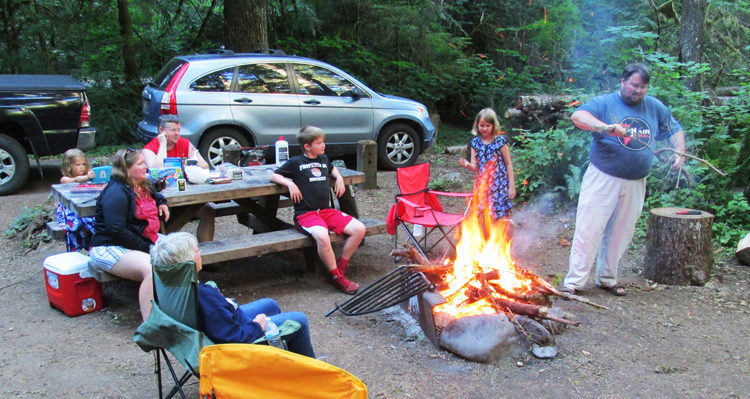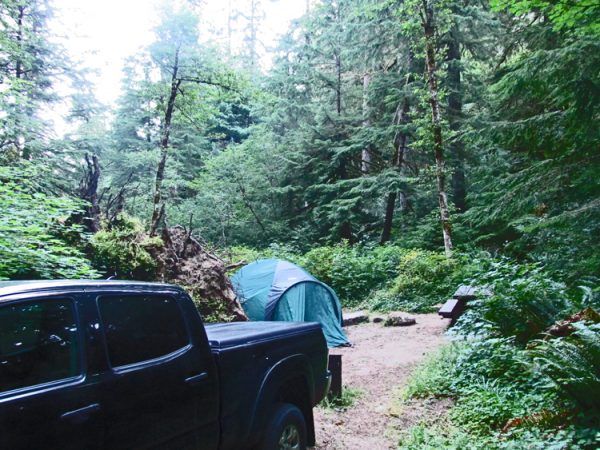
Betty and I are both retired teachers. That means that we were both out of school during the summers, but we also had very little money. Because our children were also out of school for the summers, we decided to travel the country. Camping allowed us to do so because we saved the cost of the motels and many of the meals. Our camping adventures with the kids left us with a collection of great memories, and both of our children still love camping today. As I am writing this, our daughter and her family are on a camping trip in Maryland.
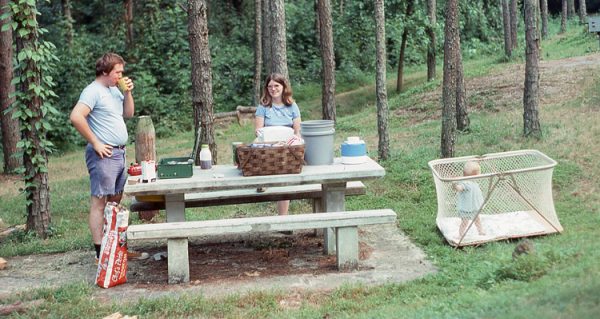
If you are planning to take your family camping for the first time, begin by going to a nearby state park for the weekend. Barkcamp State Park in Ohio is only about 20 miles from Wheeling, and Salt Fork State Park just north of Cambridge is only about 50 miles from Wheeling. Both have good tent camping areas and lots of things for the children to do. Because they are so close to home, you can jump into the car and come home if things don’t work out.
Start by making a list of the things that you will need. Even though we have been camping for many years, we still make a list. Maybe it is the tech nerd in me, but I use an Excel spreadsheet for my list. If you would like to see an example, just click this link for the camping list for our trip out west in 2017.
THE TENT
If you are going tent camping, you need a tent. Over the years, we have owned several tents. Our current tent is dome-shaped with a covered entry like an igloo. The covered entry allows us to remove muddy shoes and wet raincoats before entering the tent, thereby keeping some of the mud and dirt outside. We place a small throw rug just outside the entry flap of our tent. Our previous tent did not have a covered entry, so we created one with a 4-foot by 6-foot tarp over the main flap. Look for a tent that has flaps that you can open and close from inside the tent so that you don’t need to go outside in the middle of the night when the air gets chilly or the rain starts. Make sure to get a tent that is a little bigger than you think you will need so that you can fit your air mattresses, sleeping bags and all of your other gear inside.
If you are going to have a couple of children in the tent with you, you need at least a six-person-sized tent. If you are camping with a baby, your tent needs to be big enough to accommodate the Pack ‘n Play because allowing the baby to sleep with you on an air mattress and under a sleeping bag poses a suffocation danger. You will need that larger tent later anyway.
Click this link for more suggestions about selecting a tent, selecting a campsite, setting up your tent and taking down your tent.
THE MIDDLE OF THE NIGHT
Although I wear work or hiking shoes most of the time when we are in the woods, I keep a pair of slip-on shoes inside the tent to make that middle-of-the-night bathroom trip easier. I modified a rolling toolbox to use as a camping box inside the tent. It provides a place to sit and a place to put car keys, etc. during the night. It also provides a handy place to put a LED light that will be within easy reach during the night. I also keep a large canister of pepper spray inside the box on the tool tray, although we have never needed it.
Many national forest and national park camping areas have no electricity, so those middle-of-the-night trips to the pit toilets involve going for a walk in a dark forest. Because somewhat powerful LED flashlights are inexpensive, we always have a couple in the tent to take when we make those trips. I also take the pepper spray just to be safe. If one of the children needs to go to the bathroom, an adult needs to go with them to ensure their safety.
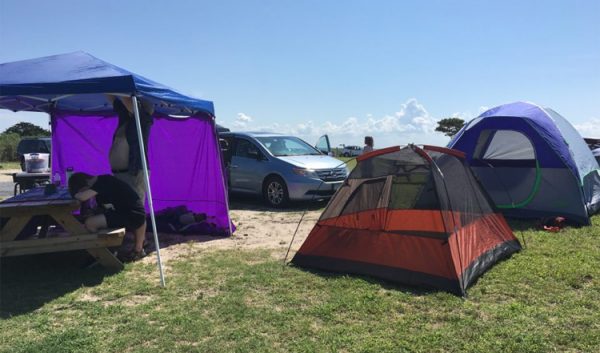
MEALTIME
We do most of our camp cooking using a two-burner propane stove and a single-burner butane stove. The butane stove was a Christmas gift from our daughter, and it is perfect for our coffee pot. The two-burner propane stove works great for cooking the eggs and toast for breakfast. We put a small skillet on one burner for the eggs and a camp toaster on the other burner. Sometimes, we will precook bacon and sausage and take it with us in the cooler. Then, we just heat it up for breakfast. That way, we don’t need to worry about disposing of hot bacon or sausage grease at the campsite. After the coffee is done, we can put a small skillet on that butane burner to heat the bacon or sausage. Pancakes also make an easy breakfast meal. We take complete pancake mix and just add water. Most of the time, we are not at the campsite at lunchtime, so our other camp meal is dinner.
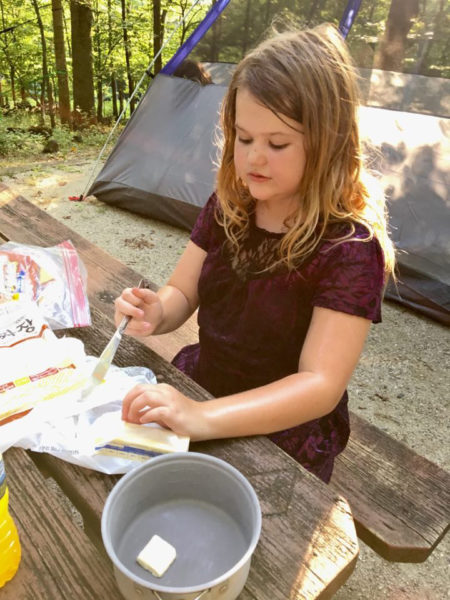
If it safe to have a fire, kids love to roast hot dogs and hobo pies or to make foil packet meals. Dessert often consists of fire-roasted marshmallows and s’mores. We carry collapsible hot dog forks because we do not want to damage any trees by cutting hot dog sticks.
Because two of our grandchildren are in the scouts, they have some great hobo pie and foil packet meal recipes. Hobo pies are sort of like sandwiches heated over the fire using a pie iron. The pie iron consists of two cast-iron halves the size of a slice of bread or slightly smaller. After coating the pie iron with cooking spray, the user places a slice of bread onto one side and puts the filling on top. Then, the second slice of bread is added like a sandwich. After adding the top piece of bread, the user coats the other half of the pie iron with cooking spray and then locks the two halves of the pie iron together squashing the sandwich between them. Then, the pie iron is placed into the fire to heat and toast the bread.
Everyone enjoys hobo pie pizza. Start by coating the first slice of bread with a very small amount of pizza sauce. Add cheese and pepperoni and the other slice of bread. Then, close the pie iron and bake it in the fire. Peanut butter and jelly make another great hobo pie combination. Just coat the first slice of bread with jelly and the second with peanut butter. You haven’t lived until you have had a hot PBJ hobo pie cooked over a campfire. During the cooking process, the pie iron needs to be rotated a couple of times to be sure that both sides are toasted. The trick is to heat the pie iron enough to toast the contents without burning the bread. The small amount of bread that protrudes from the sides of the pie iron are burned in the process, so they are discarded before the hobo pie is eaten. The children love to make and cook the hobo pies, but an older child or adult needs to remove the cooked pies from the pie irons because the pie irons are very hot when they are removed from the fire. Look online for more great hobo pie recipes.
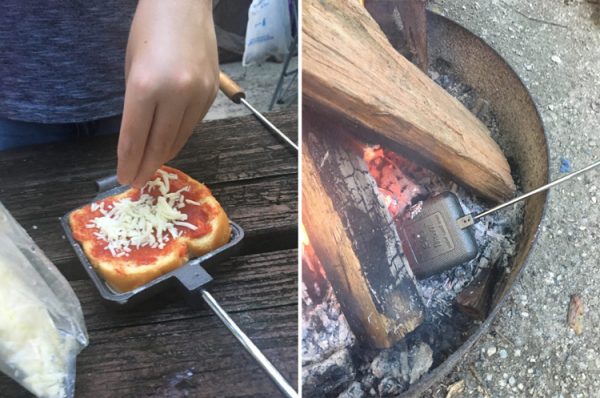
Kids also enjoy making and cooking foil pouch meals. Start out with two 18- to 20-inch-long pieces of heavy-duty aluminum foil to double the thickness for added strength. Put them on the table, shiny side up. Then place all of the ingredients onto the foil and fold the edges together to form and seal a pouch.
In order to cook the foil pouch meals, the campfire must have a good bed of coals. Place the pouch into the coals. We like to put the pouches into the coals and then cover them with more coals so that they can bake. We have used raw beef strips, but prefer to precook chicken at home to ensure that it is well cooked. The pouches can stay in the coals for a surprisingly long time while you prepare the rest of the meal. When you are sure that they are cooked, retrieve the foil pouches and put them on the picnic table to rest for a few minutes before opening them to reduce the risk of being burned by the steam.
Josh Robinson of West Liberty shared this recipe with me on Facebook: one-third pound ground beef, carrots, peppers, onions and scoop of butter. Place on hot coals and rotate. Josh also shared this advice: “Use two pieces of foil. There are places to skimp, but the foil is not one of them.” You will find plenty of great foil pouch meal recipes on the internet. While you are online, be sure to check out some of the YouTube videos about foil pouch meals.
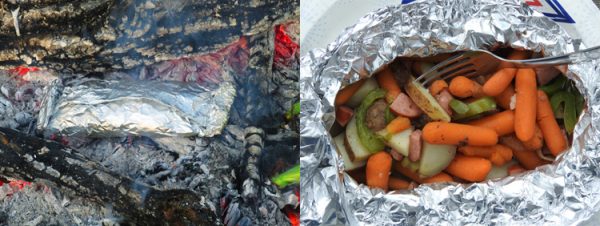
Sweetcorn cooked on a campfire provides one of the best additions to any camping meal. To preserve the maximum amount of sweetness, keep the unhusked ears of corn in a cooler until you are ready to cook them, but don’t freeze them. After the fire has developed a good bed of coals, rake the coals apart a little and place the unhusked ears of corn onto the coals. Then cover the ears with more coals. Don’t worry if the outer husks burn. That smoky flavor is great. The corn cooks in a few minutes. After you remove it from the fire, let it rest for a few minutes to make sure it finishes cooking and allow it to cool enough to handle. If you are careful when you peel down the husks, the silks come with them. Leave the husks attached. They make good handles for holding the corn.
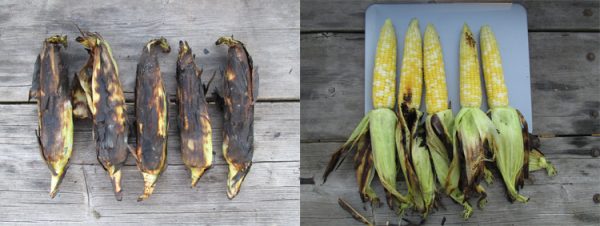
FOOD PREP, SAFETY AND STORAGE
Practice good food safety. Remember that raw meats need to be kept refrigerated to 40 degrees or less and that cooked meat needs to reach an internal temperature of at least 160-180 degrees. Isolate any raw meat from other food by putting it into zipper bags. You can cut the beef into proper-sized pieces and then freeze it prior to your trip. We never take raw poultry when we go camping because of the risk of cross-contaminating other food with salmonella.
We frequently take lunch meats and ham, but we keep those for no more than two days unless we have access to ice for the coolers. Ham and Swiss sandwiches made with whole wheat or rye bread make good lunchtime meals when we are away from camp or are on the road out in the middle of nowhere with no place to eat in sight. Eggs last several days in the cooler, and cooked bacon also keeps well. Sometimes, we will also precook a few sausage patties for breakfast on the first few of days out.
A couple of years ago, we bought two large cardboard boxes full of plastic storage containers at a Habitat fundraising event. We were pleasantly surprised to discover that they contained a lot of Lock & Lock and Tupperware containers. One of those was a plastic container designed to hold a loaf of bread. Now, we can take a loaf of bread on our camping trips without having it crushed. We found plastic boxes for eggs in the camping department at a local department store. They protect the eggs and keep them from getting soaked when the ice in the cooler melts.
You can make and freeze foil pouch meals prior to the trip. After making the foil pouches, put them into zipper bags to keep the contents from drying out in the freezer. If the frozen meals are going to contain potatoes, you might want to precook the potatoes because raw potatoes do not freeze well.
We reuse disposable water bottles by refilling them with filtered water from home. Then we freeze them and lay the frozen bottles into the bottoms of our coolers. As they thaw, they provide a steady supply of cold water that lasts several days.
We make our own trail mix using Chex type breakfast cereals mixed with nuts and other goodies. We toast the pecans to boost their flavor and also add dry roasted peanuts and whatever else looks good. Your kids might enjoy helping to make the trail mix. We place the trail mix into one-gallon Lock & Lock boxes and use it for snacking while driving when it is a long time between meals. We do not add any salt to our trail mix, so it is a very healthy snack.
Tangerines or easy-to-peel small oranges are also great snacks in the car. They keep well for several days without refrigeration.
One of the plastic containers from the Habitat sale is just the right size to serve as a trash container in our car or truck. A plastic grocery bag fits it perfectly, so we can unload it easily when we reach a rest area. When we are traveling, our drink of choice is water, so those frozen water bottles are perfect as they thaw.
CAMPFIRE SAFETY
There is something special about sitting around a campfire, especially when you are in the great outdoors surrounded by the sounds of nature, but safety must be your No. 1 consideration when it comes to fire and the children. Our two oldest grandchildren are 11 and 13 and are both in the scouts, so they know about how to make a campfire. Even so, the scout ax stays home.
Before we have a fire, we always check the fire danger rating for the area. If the fire danger is high, we skip the campfire. When a campsite has a fire ring, we use it. Pay attention to the rules and regulations for the area. Some national forests and parks do not permit the gathering of firewood. If gathering wood is permitted, make sure the children know to only gather the dead wood and never to cut any trees for firewood. If we are going on a weekend camping trip, we will often take firewood with us because we do not need to pack as much gear as for a longer trip. Let the children put together the tinder and kindling for the fire. If they are old enough, let them build the fire. Scouts are required to demonstrate fire-building skills in order to advance in rank, so camping with the family provides good supervised practice for them.
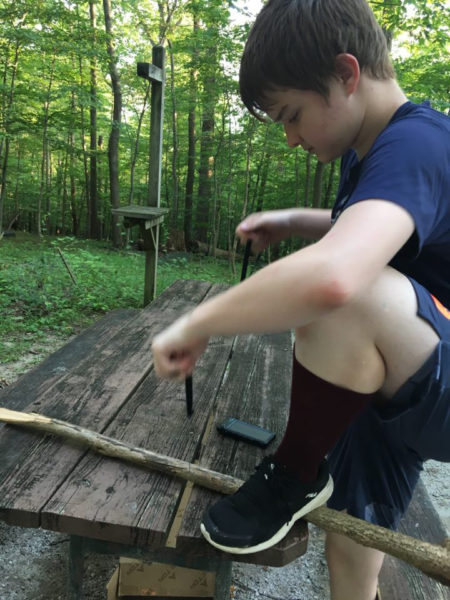
“BEAR” THESE TIPS IN MIND
When you are in the great outdoors, safety should always be on your mind. If you are camping in bear country, make sure to put all of the food items into your vehicle. This includes your garbage bag. Many of the national park and national forest camping areas have bear-resistant refuse containers where you can put the garbage before going to bed each night.
Never approach any bear or other wild animal. If you are camping in a state park or other more developed camping area, your campsite may be visited by raccoons or skunks each night. If you leave a cooler or garbage bag out when you go to bed, you may awaken to find the contents scattered all over the area. You can avoid that problem by disposing of the garbage and putting the cooler inside your vehicle.
Although raccoons look cute and cuddly, they are powerful animals. Usually, raccoons and skunks run away from humans. If you encounter any animals in your camp when you get up for that middle-of-the-night restroom trip, do not shine your flashlight right at them because it will blind them. Instead, shine it at the woods and make noise that should chase them away. As soon as you are back in bed, they will return looking for that partially eaten hot dog that one of the kids dropped.
As I write this, two wildlife encounters are in the news. In one case, a bison gored a 13-year-old girl at Yellowstone National Park. She and her parents had approached it to within a few feet to take a picture. The other involved a bear attack on a woman. In both cases, the victims were too close to the wild animals.
LEAVE NO TRACE
The last thing that the children can help to do is clean up. After packing up the tent and all of the gear, have everyone police the campsite picking up any piece of litter no matter how small, even if it was left by someone else. Always leave no trace and leave the camping area in as good of shape, or better, as it was when you arrived. Before leaving, make sure your fire is completely out. Separate any coals left in the fire ring and soak them with water.
MAKE MEMORIES
As parents, the most important thing that we can do for our children is to spend quality time doing things with them. Camping is a great way to do so while making memories that you and they will cherish for a lifetime.
• Earl Nicodemus is retired after 40 years as a professor of Instructional Technology at West Liberty University. He helped to form the West Liberty Historical Society, and he and his family maintained the historic West Liberty Cemetery from 1985 to 2016. In 2016, Earl was named as a West Virginia History Hero. His other interests include gardening and fishing.


